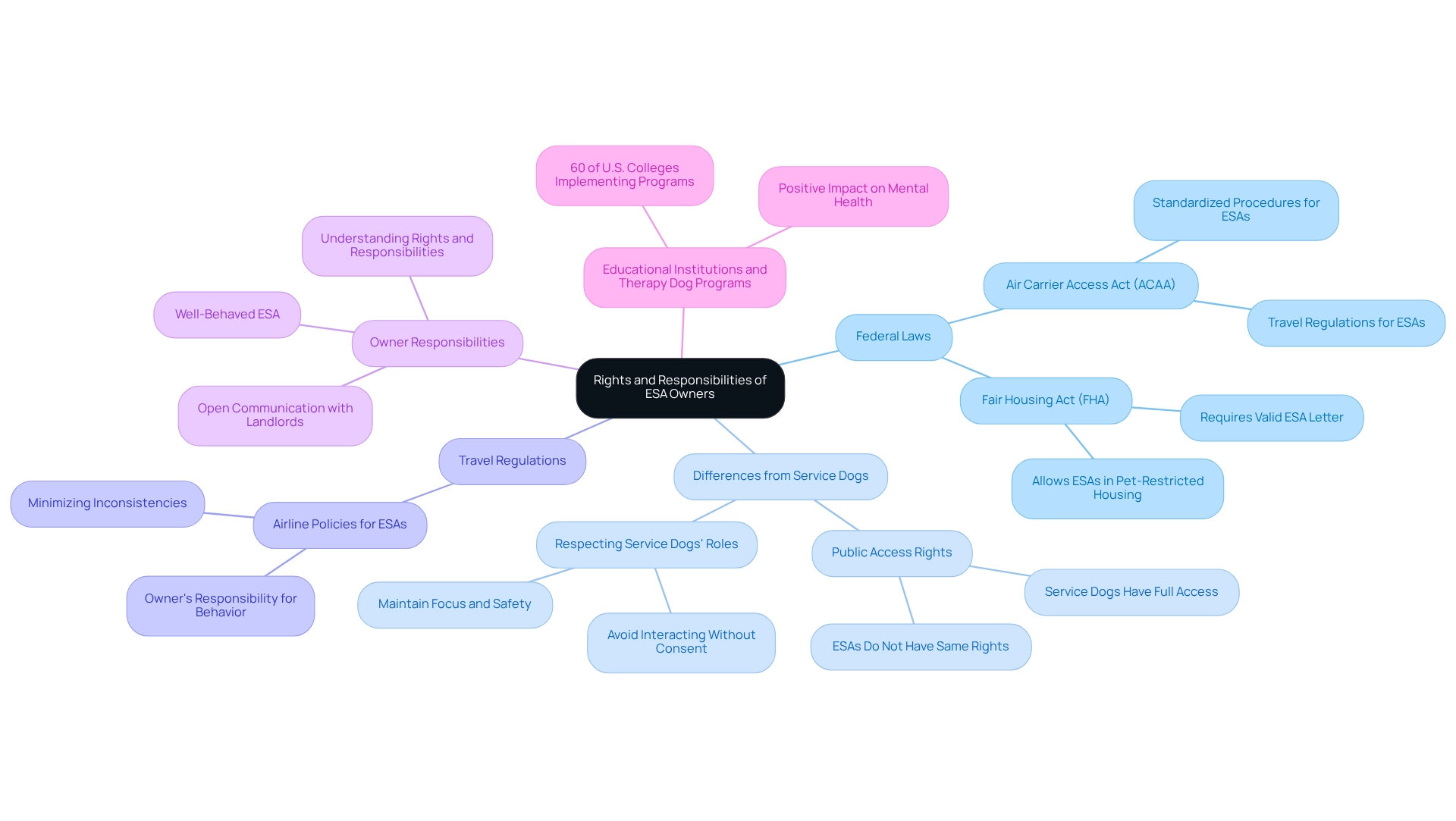

How to Certify ESA Dog: Steps for Pet Owners
by Lena Park
Last updated: July 10, 2025
Verified and Approved by:
Angela Morris,
MSW, LCSW
Fact Checked

Overview
For those navigating the emotional challenges of mental health issues, the journey can often feel overwhelming. It’s important to recognize that you are not alone in this struggle. One supportive solution is to certify an Emotional Support Animal (ESA) dog. To do this, pet owners should reach out to a licensed mental health professional who can provide a legitimate ESA letter. This letter serves as a vital confirmation of the necessity of the animal for emotional support, offering a sense of validation and comfort.
The process of obtaining an ESA letter is not just a formality; it is an essential step towards accessing the housing and travel accommodations that can make a significant difference in your life. Proper documentation is crucial, and it empowers ESA owners by highlighting their rights and responsibilities under relevant laws. It’s a reminder that you deserve the support you need.
As you consider the benefits of having an ESA, think about the companionship and emotional relief these animals can provide. They can be a source of unconditional love and support, helping to ease anxiety and loneliness. Remember, the support available to you is not just a piece of paper; it’s a commitment to your well-being.
In this journey, it’s important to feel cared for and understood. You have the right to seek the support that can help you thrive. If you’re feeling uncertain or overwhelmed, know that there are professionals who can guide you through this process with compassion and understanding.
Introduction
In a world where mental health challenges are increasingly recognized, many individuals find themselves seeking comfort and stability. Have you ever felt overwhelmed by anxiety, depression, or PTSD? In these moments, Emotional Support Animals (ESAs) can emerge as vital companions, offering unconditional emotional support that goes beyond what service animals provide.
The bond between humans and their ESAs not only enhances quality of life but also fosters a profound sense of belonging and connection. As we gain a deeper understanding of ESAs, the process of obtaining the necessary documentation and navigating the legal rights associated with these cherished companions becomes clearer.
This article delves into the essential aspects of ESAs, including:
- Defining their role
- Assessing eligibility
- Understanding the rights and responsibilities of ESA owners
Our aim is to offer a comprehensive guide for those looking to benefit from the therapeutic presence of these remarkable animals, reassuring you that support is available on your journey to healing.
Define Emotional Support Animals and Their Role
Emotional Support Animals (ESAs) are cherished companions that provide essential comfort to those navigating emotional or psychological challenges. Unlike service animals, which are trained for specific tasks, ESAs primarily serve as loving companions, helping to alleviate symptoms associated with mental health conditions such as anxiety, depression, and PTSD. The presence of an ESA can significantly enhance a person’s quality of life, reducing feelings of loneliness and promoting emotional stability.
Research highlights the tangible benefits of having an emotional support animal; for instance, studies show that children with Autism Spectrum Disorder (ASD) often display improved social behaviors when interacting with animals, showcasing the positive influence of animal companionship on mental well-being. As Nicole Cosgrove insightfully notes, “Animal-assisted therapy is showing to be particularly advantageous for children and individuals with distinct mental wellness requirements,” underscoring the vital role of ESAs in therapeutic environments.
Understanding the significance of ESAs is crucial for pet owners who wish to know how to certify esa dog, as it emphasizes the importance of obtaining the necessary documentation to affirm their therapeutic benefits. Individuals looking for an ESA can receive a prescription through licensed mental health professionals or general practitioners, with Wellness Wag’s telehealth services simplifying this process and making it more accessible. This documentation not only addresses the emotional needs of individuals but also facilitates access to housing and travel accommodations, ensuring that the bond between pet and owner is recognized and protected under relevant laws.
Moreover, it is important for pet owners to grasp the differences between ESAs and service dogs, particularly concerning legal rights and access, as well as the responsibilities associated with having an ESA in student housing. If you are considering how to certify esa dog, we recommend following these steps:
- Consult with a licensed mental health expert to discuss your needs.
- Obtain a legitimate ESA letter through Wellness Wag’s telehealth services.
- Familiarize yourself with your rights and responsibilities as an ESA owner, especially in housing situations.
Should you have any questions or concerns about this process, please feel free to refer to our FAQ section or reach out to us directly.
Assess Eligibility for an ESA
Qualifying for an Emotional Support Animal (ESA) is a journey that begins with understanding the emotional struggles that many individuals face. To be eligible, one must have a diagnosed mental condition that significantly impacts daily life. Conditions such as anxiety disorders, depression, and PTSD are prevalent and recognized as leading causes of disability worldwide. The first step in this process involves a quick assessment through Wellness Wag, where you can share your unique situation and emotional support needs. This initial step leads to a personalized consultation with a licensed medical doctor, who will conduct a thorough evaluation to determine if an ESA is necessary for your emotional support.
During this compassionate evaluation, a licensed mental health professional (LMHP) will assess your mental health status and provide documentation confirming your need for an ESA. Honesty and thoroughness during this assessment are crucial, as they validate the necessity of having an ESA. Research indicates that nearly 47% of individuals seeking ESAs identify as male, showcasing the diverse demographic in need of support. At Wellness Wag, we are dedicated to serving this diverse audience by offering a simplified process for obtaining ESA letters, ensuring that people from various backgrounds can access the support they require. It’s important to note that non-white individuals with mental health conditions often encounter additional obstacles, such as extended jail stays and solitary confinement, underscoring the need for accessible mental health resources.
Real-world examples illustrate that mental health assessments for ESA certification can vary, yet they typically involve a thorough examination of the person’s mental health history and current challenges. These evaluations often include discussions about personal experiences and how conditions affect daily life. Common qualifying conditions for emotional support animals include anxiety disorders, depression, and other emotional or psychological disabilities. As we look ahead to 2025, eligibility criteria continue to emphasize the necessity of an ESA for emotional support, with expert advice highlighting the importance of a comprehensive evaluation by a qualified professional. This process not only validates the need for an ESA but also ensures that individuals receive the appropriate support to enhance their well-being.
Moreover, studies have shown that general dog ownership can significantly reduce stress levels and improve mood, highlighting the emotional benefits of having an ESA. In addition to providing ESA letters, Wellness Wag has introduced pet insurance options, reflecting our commitment to supporting the overall well-being of pet owners and their emotional support animals. This comprehensive approach ensures that clients receive not only the necessary documentation but also ongoing support for their pets. Importantly, ESAs play a vital role in assisting students with disabilities, alleviating symptoms related to their conditions and promoting equal opportunities to fully enjoy residential life.
Obtain Your ESA Letter from Licensed Professionals
Navigating the journey of mental health can be incredibly challenging, and for many, the presence of an Emotional Support Animal (ESA) can provide much-needed comfort. Once you have been assessed and verified as qualified for an ESA, the next important step is to understand how to certify esa dog by obtaining your ESA letter from a licensed mental wellness expert. This letter, which should be printed on official letterhead, must include essential details:
- Your name
- The date of the evaluation
- The diagnosed mental health condition
- A clear statement affirming the necessity of the ESA for your emotional support
Thankfully, many licensed professionals now offer this service online, making it easier than ever to secure your letter through Wellness Wag. After submitting the required forms, you will be connected with a licensed medical professional for a personalized consultation and thorough evaluation to assess your eligibility for an ESA. Upon confirmation by our team, you can expect to receive a professionally crafted ESA letter with legal recognition within 24 hours of your consultation.
Once you have your ESA letter, it’s crucial to keep it safe and accessible, as you will need to present it when seeking housing or travel arrangements that accommodate emotional support animals. This documentation is vital in advocating for your rights under the Fair Housing Act and Air Carrier Access Act, especially given recent changes that impact how to certify esa dog travel regulations. For instance, Air Canada no longer recognizes emotional support animals, emphasizing the need for proper documentation, including a U.S. DOT form, to travel with a psychiatric service dog.
As Jillian Ferrell, a researcher in the Department of Psychology at Utah State University, notes, “Due to the internet-letter fraud issue and accounts of emotional support animals such as pigs, ducks, and dogs being out of control on planes, American air carriers no longer permit these animals on any flights.” This underscores the importance of having a legitimate ESA letter.
Furthermore, recent case studies, such as those addressing the ‘Risks Emotional Support Animals Encounter in Air Travel,’ highlight the considerable dangers faced during air travel due to changes in the Air Carrier Access Act, reinforcing the need for appropriate documentation for your emotional support animal. Remember, you are not alone on this journey; support is available to help you navigate these complexities.
Understand Your Rights and Responsibilities with an ESA
As an ESA owner, it’s essential to understand your rights under federal laws such as the Fair Housing Act (FHA) and the Air Carrier Access Act (ACAA). The FHA allows individuals with emotional support animals to reside in places that typically enforce pet restrictions, provided they have a valid ESA letter. Open communication with your landlord and submitting the necessary documentation are vital steps in this journey.
While emotional support animals do not share the same public access rights as service animals, protected under the Americans with Disabilities Act (ADA), it’s important to recognize that service dogs do have complete public access rights, allowing them to accompany their handlers in public spaces like restaurants and shops. This distinction is crucial for understanding the different rights and responsibilities associated with emotional support animals and service dogs. Additionally, service dogs must be respected in their working role; interacting with them without consent can disrupt their duties and jeopardize the safety and well-being of their handlers. Therefore, giving service dogs and their handlers space and observing proper etiquette is essential for maintaining their focus.
When it comes to travel, ESAs are allowed in certain situations under the ACAA, which has established standardized procedures to minimize inconsistencies in airline responses regarding ESAs. It’s also important to remember that the responsibility of ensuring your ESA is well-behaved and does not disturb others rests with you as the owner. According to HUD, licensed medical professionals can provide reliable ESA documentation remotely, making the process easier for those seeking support. Furthermore, case studies show that educational institutions are increasingly embracing therapy dog programs, with 60% of U.S. colleges implementing such initiatives, highlighting the growing acknowledgment of the emotional benefits of animal companionship.
Rebecca F. Wisch notes that if the housing provider can demonstrate that the animal poses a direct threat to the health or safety of others or that its tenancy would cause significant physical damage to the property of others, they may refuse the accommodation. Being well-informed about your rights and responsibilities, including the differences between ESAs and service dogs, will empower you to navigate any challenges that may arise while living with your ESA, fostering a harmonious relationship with your housing provider and during travel.

Conclusion
Emotional Support Animals (ESAs) are truly invaluable companions for those navigating the complexities of mental health challenges. They offer not just companionship but also a sense of emotional stability, helping to ease the burdens of anxiety, depression, and PTSD. For individuals seeking this supportive relationship, understanding how to define an ESA, assess eligibility, and obtain the necessary documentation is essential. By working closely with licensed mental health professionals, one can receive the appropriate ESA letters that affirm the need for these remarkable companions.
It is equally important for ESA owners to be aware of their rights and responsibilities. While the unique benefits of ESAs are clear, they do not carry the same public access rights as service animals. This distinction highlights the need for open communication with landlords and a commitment to following legal requirements under the Fair Housing Act and the Air Carrier Access Act. By staying informed, ESA owners can effectively navigate the challenges of housing and travel, ensuring that their beloved animals continue to provide the emotional support they need.
Ultimately, the journey to obtaining an ESA transcends mere paperwork; it is about nurturing a profound bond that fosters healing and enhances well-being. As society increasingly recognizes the importance of mental health, so too does the understanding of the essential role that ESAs play in offering comfort and companionship. Embracing the support of an ESA can be a transformative step toward a healthier and more fulfilling life.
Frequently Asked Questions
What are Emotional Support Animals (ESAs)?
Emotional Support Animals (ESAs) are cherished companions that provide essential comfort to individuals navigating emotional or psychological challenges. They primarily serve as loving companions, helping to alleviate symptoms associated with mental health conditions such as anxiety, depression, and PTSD.
How do ESAs differ from service animals?
Unlike service animals, which are specifically trained to perform tasks for individuals with disabilities, ESAs primarily provide emotional support and companionship without specialized training for specific tasks.
What benefits do ESAs provide?
ESAs significantly enhance a person’s quality of life by reducing feelings of loneliness and promoting emotional stability. Research shows that they can improve social behaviors in children with Autism Spectrum Disorder (ASD) and have therapeutic advantages for individuals with distinct mental wellness requirements.
How can someone obtain an ESA?
Individuals can receive a prescription for an ESA through licensed mental health professionals or general practitioners. Services like Wellness Wag’s telehealth make this process more accessible.
What is the importance of obtaining documentation for an ESA?
Obtaining the necessary documentation affirms the therapeutic benefits of an ESA and facilitates access to housing and travel accommodations, ensuring that the bond between pet and owner is recognized and protected under relevant laws.
What steps should one follow to certify an ESA dog?
To certify an ESA dog, follow these steps: 1) Consult with a licensed mental health expert to discuss your needs. 2) Obtain a legitimate ESA letter through Wellness Wag’s telehealth services. 3) Familiarize yourself with your rights and responsibilities as an ESA owner, especially in housing situations.
What should ESA owners know about their rights and responsibilities?
ESA owners should understand the differences between ESAs and service dogs regarding legal rights and access, as well as the responsibilities associated with having an ESA, particularly in student housing.
Certify Your Emotional Support Animal Today

Why You Can Rely on Us?
At Wellness Wag, we believe your pet deserves care rooted in both science and compassion. Each article is carefully researched, written in clear language for pet owners, and then reviewed by qualified professionals to ensure the information is evidence-based, current, and practical for real-life care. Our goal is to help you feel confident in making informed decisions about your pet’s health and well-being.
Reviewed by
Angela Morris, MSW, LCSW
Angela is a licensed clinical social worker with 20 years of experience in patient advocacy and community mental health. She has assisted numerous clients with ESA evaluations and brings a deep understanding of disability accommodations, ensuring that all information is accurate, supportive, and practical.

Written by :
Lena Park
Last Updated :
July 10, 2025












